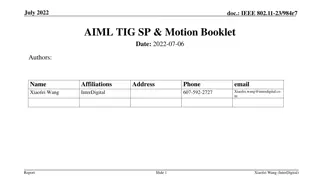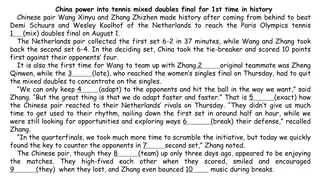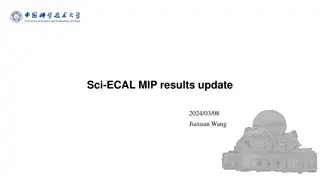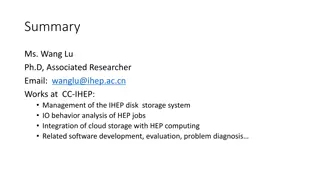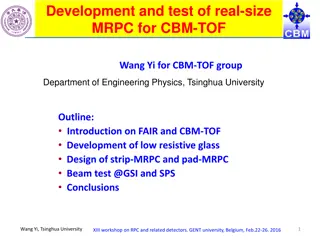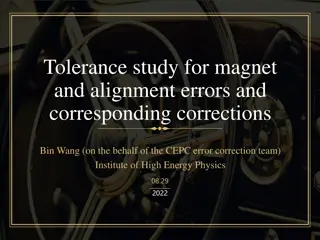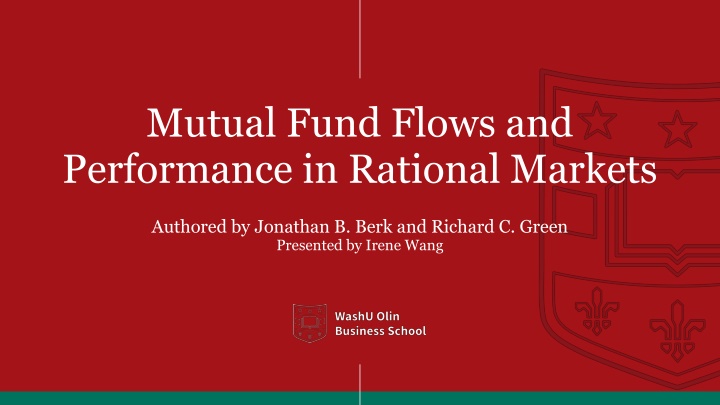
Mutual Fund Flows and Performance in Rational Markets by Berk and Green
Explore the rational relationship between mutual fund flows and performance in the context of capital provision, managerial ability, and learning. The model addresses factors such as differential returns, uncertainty, costs, and fund flow dynamics based on fund performance.
Download Presentation

Please find below an Image/Link to download the presentation.
The content on the website is provided AS IS for your information and personal use only. It may not be sold, licensed, or shared on other websites without obtaining consent from the author. If you encounter any issues during the download, it is possible that the publisher has removed the file from their server.
You are allowed to download the files provided on this website for personal or commercial use, subject to the condition that they are used lawfully. All files are the property of their respective owners.
The content on the website is provided AS IS for your information and personal use only. It may not be sold, licensed, or shared on other websites without obtaining consent from the author.
E N D
Presentation Transcript
Mutual Fund Flows and Performance in Rational Markets Authored by Jonathan B. Berk and Richard C. Green Presented by Irene Wang
Contents I. Research Background II. Model Interpretation III. Conclusion IV. My Opinion
Research Background Issue: There is little evidence that mutual fund managers outperform passive benchmarks. The performance of mutual fund managers appears to be largely unpredictable andinconsistent. Aim: Construct a rational model for the relationship of fund flows and performance.
Research Background The model is based on four elements: There is competitive provision of capital by investors to mutual funds. There is differential ability to generate high average returns across managers but decreasing returns to scale in deploying these abilities. Thereislearning aboutmanagerial abilityfrom pastreturns. Thereisnomoral hazard or asymmetricinformation.
Model Interpretation -Significant parameters Assumptions: Funds differ in their managers ability to generate expected returns in excess of those provided by a passive benchmark. Uncertaintyis idiosyncratictothe manager. Costs are independent of ability and are increasing and convex in the amount of funds under active management. Fund managers aresimply paid a fixedmanagement fee. Theexcesstotal payout to investorsoverpassivebenchmark: ??= ? + ??:returnonactivelymanagedfunds,inexcess of thepassivebenchmark,withoutcostsandfees :sourceof differentialabilityacrossmanagers ??:error term,normallydistributedwith[0, 2] 1 = 2:precisionof uncertainty ? ??:costsincurredwhenactivelymanagingafundof size??,for allq 0, ? ?? 0,? ?? >0, and? ?? >0
Model Interpretation -Significant parameters Excess return over benchmark that investors receive in period t+1: Unit cost associated with investing in the actively managed fund Prior about the ability of the fund s management is that is normally distributed with mean 0 and variance ?2. Precision of the prior is denoted = 1 ?2. Update posterior mean of management ability based on return s history at time t
Model Interpretation Analysis of funds flow and performance Funds flow to and from each fund so that the expected excess return to investing in any surviving fund is zero. Implications Good performance results in an inflow of funds. Flows to younger funds respond much more dramatically to performance than flows to more mature funds.
Model Interpretation Analysis of cross-sectional distribution of funds As long as t is greater than or equal to , the fund survives through period t. ??? : conditional probability on the fund s survival though period t ??? =???? ??? : joint probability that a fund survives through period t and has t ???? : joint probability that a fund survives through period t and has t , conditional on manager talent ?? : associated density
Model Interpretation Analysis of cross-sectional distribution of funds
Model Interpretation Empirical comparison Select value for parameters based on existing evidence in literature.
Model Interpretation Empirical comparison Light bars are the actual survival rates computed from the CRSP mutual fund database. Dark bars are what the model predicts the survival rates should be. Line marks the total number of funds that could have survived at each age.
Model Interpretation Empirical comparison The dashed line shows the flow of funds for two-year-old funds produced by the model. The solid lines represent nonparametric estimates and 90 percent confidence intervals.
Model Interpretation Empirical comparison The prior distribution over management ability using their parameter values.
Conclusion Derive empirical expressions of a rational model for active portfolio management Reproduce the salient features of the empirical evidence as equilibrium outcomes in a rational model Fund flows rationally respond to past performance in the model The flow-performance relationship is consistent with high average levels of skills
My opinion Contribution Limitation Interesting topic Detailed analysis of assumptions validation Explicit expressions Inconsistences with empirical evidences Little analysis on why phenomenon happen Focus more on the derivations of model rather than explanations

